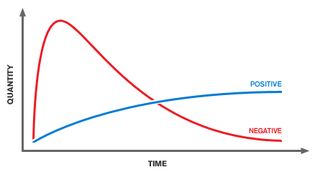The Redesign Response Curve
Anyone that’s stepped into the blast radius of a major redesign can tell you a thing or two about typical user reactions. From riding the bomb Slim Pickens-style to lab-coat-and-safety-goggles observation, I’ve weathered my share. Make a fundamental change to an existing product and reaction tends towards the swift and merciless.
In every redesign I’ve ever been involved with user responses have followed a predictable pattern. You can group them into two broad category: Negatives and Positives. (No creativity here—they’re exactly what they sound like.) Negatives tell you how much your update pulls a serious vacuum. Positives testify that you’re the bee’s knees. Both come from self-selecting users, since contact requires some kind of effort. (No matter how small—it’s what highfalutin types call a “barrier to entry”.) Kicking in the moment you pull back the curtain on your zippy new gewgaw, it looks something like this:

Almost instantly there’s the glut of reactionary feedback—the Who Moved My Cheese? set. Glean what you can from these comments, look for common threads, but remember not to let that five-hundredth “WTF?! Ur new design iS teh suck,” e-mail get you down. That’s the important bit. As designers, developers, and all around “Builders of the Interwebs” we pour or hearts and souls into our projects. (At least if you’re like me you do.) Even ironclad stalwarts can’t help but have their outlook dimmed a bit by that first feedback wave.
Stick it out though and—if you’ve done your job well—you’ll be through the squall, sitting pretty at the other end of the graph soon enough. Eventually the rest of the crowd chimes in. And the remaining negative comments shed their emotional edge, taking on a more constructive character.
Keep the wheat, lose the chaff. Quickly, lest you stew in it.
Earlier today I got to wondering what makes the Negatives so vocal compared to their Positive peers. Even when your audience research finds nothing but giddy users you don’t hear from them much. But even small sets of Negatives don’t have trouble making their presence known.
During an interesting chat Chris Fahey set me on the right track by pointing out something I’d overlooked: Negatives want to affect change, Positives are confirming assent. I hadn’t thought of it that way before, but he’s absolutely right, and it explains a lot about their respective behavior. Negatives have the motivation to act since they want something done. Positives stay mum because, ultimately, they want nothing done.